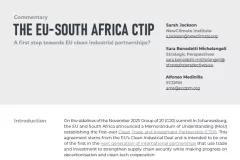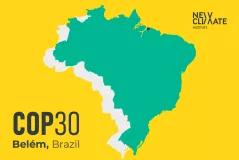Plastics are commonly recognised as an environmental problem – one that clogs rivers, harms marine life and threatens human health through toxic exposure and microplastics. However, their impact on the climate is just as serious.
Plastics are made from fossil fuels. From the moment fossil fuel feedstocks are extracted and processed to make plastics, to the moment where they are incinerated, landfilled or discarded, greenhouse gas emissions are generated at every stage of its life cycle. The plastics sector already contributes an estimated 3–5% of global emissions, with emissions projected to rise steeply as plastic demand soars.
As the final round of negotiations on the international legally binding instrument on plastic pollution – the first of its kind to address plastics pollution – resumes in Geneva from 5 to 14 August, negotiators have a crucial opportunity to tackle these interconnected climate and plastics environmental crises.
An ambitious treaty should not only include strong commitments to reduce plastic pollution but also clear targets for addressing the sector’s climate impact. Plastic pollution and emissions are inherently linked, and both must be tackled together, our experts say.
In this Q&A, our experts explain why cutting plastics production is critical for climate action, drawing on insights from our upcoming report. The report, to be launched in September, examines emissions across the plastics life cycle, outlining the most effective mitigation strategies and identifying mitigation priorities for four major players of the sector – United States, Europe, Saudi Arabia and China.
Q. How do plastics contribute to global greenhouse gas emissions?
Across the entire life cycle of plastics, the production phase is by far the most emissions-heavy, accounting for an estimated 90% of total emissions. This is largely due to energy-intensive processes like steam cracking. End-of-life treatment adds about 10% of emissions globally, with incineration being the most emissions-intensive disposal method available.
Three main factors determine the emission intensity of plastic production:
- Type of feedstock: Plastics can be made from coal, crude oil or fossil gas. Among these, coal is by far the most carbon-intensive, followed by oil, then gas.
- Type of plastic: More complex plastics require more energy to produce, resulting in higher emissions compared to simpler types.
- Regional energy mix: Regions that rely heavily on coal for plastic production tend to have the highest emissions, followed by those using oil and fossil gas.
Q. What are the guiding principles for a net-zero emissions plastic sector introduced in the report, and what are the key mitigation strategies for reducing emissions?
The guiding principles for achieving a net-zero emissions plastic sector are based on three main goals: reducing the need for virgin plastic, producing the necessary plastics without fossil feedstocks and powering plastic production processes with clean energy.
These goals underpin three core mitigation strategies: minimising plastic production, enhancing circularity and decarbonising production.
Minimising plastic production is a foundational strategy. By reducing the overall volume of plastics produced, it can ease pressure on the other two strategies. It also directly lowers the amount of plastic waste generated.
Improving circularity reduces demand for virgin plastic and keeping materials in use for longer. This not only helps cut emissions from new production but also limits the amount of plastic that ends up in the environment.
Decarbonising plastic production addresses emissions from the plastics that will still be needed. Emissions reductions here come from two fronts – replacing fossil-based feedstocks with alternatives and switching to clean energy sources for production processes.
Furthermore, these strategies must be integrated in a coherent way, focusing on mature, readily available solutions – such as direct elimination of plastic products or mechanical recycling – while avoiding over-reliance on less developed and unproven technologies. This can help ensure that emissions reductions are both effective and feasible.
Q. What should policymakers consider when designing emissions reduction strategies, and what systemic changes are needed beyond technical fixes?
Decarbonising the plastics sector is not just about rolling out new technologies. It also requires a broader, systemic change. Minimising plastic production includes cutting back on unnecessary plastic use and shifting away the current consumption model built around cheap, disposable products. This includes behavioural changes to build a system that prioritises durability and reuse, especially in high-income countries with the highest per capita consumption.
On the technology side, there are key challenges policymakers should consider. Many key mitigation technologies are still in early stages of development and deployment. Over-reliance on unproven solutions, such as carbon capture utilisation and storage and green hydrogen, treating them as ‘silver bullets’ and assuming they will be available at scale in time risks delaying action and prolonging dependence on fossil fuels. Other technologies that may seem promising, such as bio-based feedstock and chemical recycling, may also carry trade-offs, shifting environmental burdens elsewhere.
At the same time, full decarbonisation will require these technologies at scale. It is essential to invest in research, development, demonstration and deployment (RDD&D) to speed up their progress. But that must be paired with a precautionary approach – acknowledging the risks and limitations of these solutions.
To guide this, our report proposes a clear sequencing of actions: start with mature, short-term actions that can deliver immediate emissions cuts, while preparing for longer-term solutions. This approach helps reduce cumulative emissions and avoids getting locked into unsustainable pathways.
Q. There are national and regional differences in plastics production systems. Do these differences matter for global policymaking and why?
National and regional characteristics are important to consider in global plastics policymaking. These differences shape each country’s role in fossil fuel extraction, feedstock synthesis, plastic production, consumption and trade – all essential dimensions of the global plastic production system.
Countries with access to fossil fuels and advanced petrochemical infrastructure tend to dominate feedstock production. Plastic manufacturing is often concentrated in regions with large-scale industrial capacity. Trade flows reflect these strengths: some countries focus on raw materials, others in finished products. The system is highly interconnected and complex, with many countries acting as both major exporters and importers.
In our report, we analyse four major players – the US, the EU, China and Saudi Arabia, each of which plays a distinct role in the global plastics value chain.
Q. What roles do these countries play in the global value chain?
- China is the world’s largest producer and consumer of plastics by volume. Its production is largely based on coal and, due to its scale, China is also the largest importer of refined products – the basic building blocks derived from crude oil and fossil gas that are further processed into plastics – as well as the top exporter of plastic goods.
- The EU ranks third globally in plastic production, though its role is gradually declining. It relies on crude oil-based feedstocks and is active in both importing and exporting across all stages of the plastics value chain. The EU is also the second-largest per capita consumer of plastics.
- Saudi Arabia is a major producer and exporter of fossil-based feedstocks, particularly refined products, thanks to its abundant fossil resources and petrochemical capacity. However, it is not among the top producers or consumers of plastic products.
- The US is the world’s second-largest plastics producer and the highest per capita consumer. Its production relies heavily on fossil gas, particularly shale gas, and it is the world’s largest exporter of refined products used in plastic manufacturing.
Q. What should be the top priorities now to move toward net-zero plastics, and who should drive these changes?
Countries that dominate global plastic production and consumption, many of which are also major economies, should take the lead through domestic policy, international cooperation and investment in research, development, demonstration and deployment (RDD&D) of emerging technologies. They also have a responsibility to provide financial and technical support for other regions to enable a global transition.
High-consuming countries need to prioritise reducing plastic use and driving systemic shifts in how plastics are consumed and perceived. Meanwhile, countries with lower consumption levels should avoid locking in future plastic dependency as their populations and economies grow.
Alternatives to plastic must be introduced through regionally tailored strategies that ensure high sustainability standards and avoid shifting environmental impacts to other new domains. At the same time, circularity also needs to be scaled globally. Countries with advanced recycling systems can support waste management and technology transfer in regions with less developed infrastructure.
Major plastic-producing countries must decarbonise their production systems. Countries with ageing infrastructure should prioritise investments in clean technologies, while countries with relatively new plastic production facilities should plan for retrofitting to cleaner feedstocks and adapting to cleaner energy sources. Fossil fuel-dependent economies need to rethink their role in a decarbonised plastic sector and contribute to supporting a global transition.
Q. Are there policy examples from any countries that could be scaled or replicated?
Currently, there are very few climate policies that directly address emissions from plastics. Most existing policies around plastics focus on reducing environmental pollution rather than emissions from production. Examples include China’s Plastic Pollution Control Action Plan and the EU’s Single-Use Plastic Directive. The EU’s Packaging and Packaging Waste Regulation promotes circularity but does not target emissions directly. However, many of these policies often have limited scope, vague targets and do not address the systemic or behavioural changes needed for broader transformation.
Policies that specifically target the decarbonisation of plastics are mostly missing. In some cases, existing policies may even increase emissions – for example, China’s support for coal in the chemical sector or Saudi Arabia’s push to expand plastics production through fossil gas.
Q. With the negotiations on the global plastics treaty approaching, what would a climate-aligned plastics treaty include?
A climate-aligned plastics treaty should focus on immediate action to reduce plastic production and demand – through cutting overall consumption, promoting alternatives and enhancing circularity. Since these measures also address plastic pollution, the international legally binding instrument on plastic pollution (ILBI) offers a key opportunity to set globally agreed targets that deliver both environmental and climate benefits.
At the same time, full decarbonisation of plastic production will be essential. Aligning the ILBI process with the UNFCCC could help drive stronger national action by creating shared incentives and ensuring climate and plastics policies are developed in coordination rather than in isolation.
The upcoming negotiations are a crucial chance to embed climate considerations into global plastics governance. Success will depend not only on commitments to reduce plastic pollution, but also on clear ambition to tackle emissions – recognising that plastic pollution and climate change are closely interconnected and must be addressed together.
Compiled and edited by Laeticia (Hyunju) Ock, writer and editor at NewClimate Institute.







